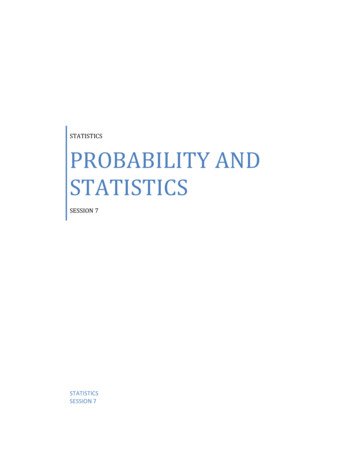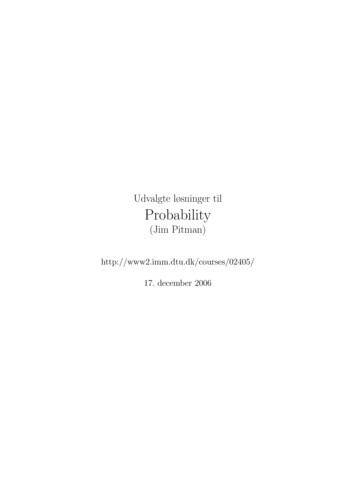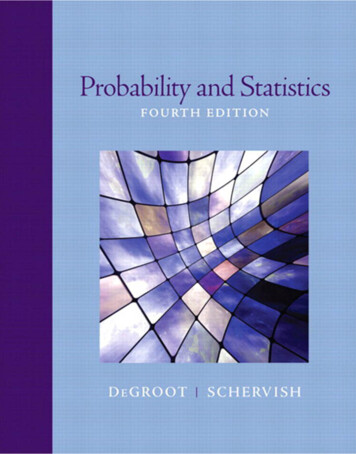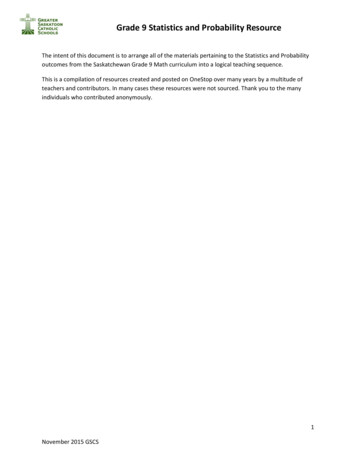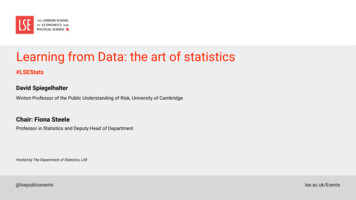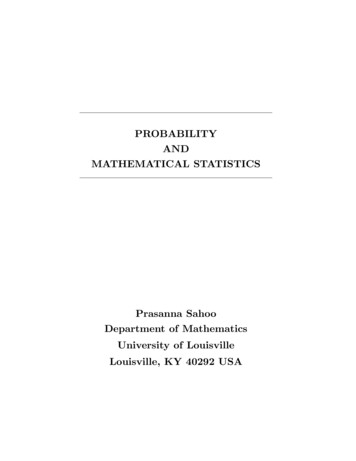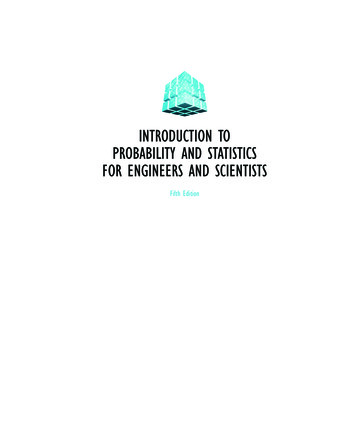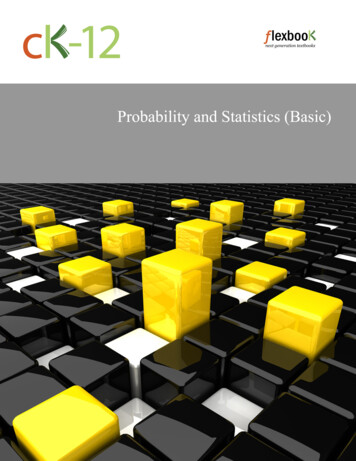
Transcription
Probability and Statistics (Basic)CK-12 Foundation
CK-12 Foundation is a non-profit organization with a mission to reduce the cost of textbookmaterials for the K-12 market both in the U.S. and worldwide. Using an open-content, webbased collaborative model termed the “FlexBook,” CK-12 intends to pioneer the generationand distribution of high-quality educational content that will serve both as core text as wellas provide an adaptive environment for learning.Copyright 2009 CK-12 Foundation, www.ck12.orgExcept as otherwise noted, all CK-12 Content (including CK-12 Curriculum Material)is made available to Users in accordance with the Creative Commons Attribution/NonCommercial/Share Alike 3.0 Unported (CC-by-NC-SA) License ), as amended and updated by Creative Commons from timeto time (the “CC License”), which is incorporated herein by this reference. Specific detailscan be found at http://about.ck12.org/terms.
AuthorBrenda MeerySupported by CK-12 Foundationiii
iv
Contents1An Introduction to Independent Events1.12An Introduction to Conditional Probability2.13Estimating the Mean and Standard Deviation of a Normal DistributionCalculating the Standard DeviationConnecting the Standard Deviation and Normal DistributionMeasures of Central Tendency6.16.26.37Standard DistributionsThe Shape, Center and Spread of a Normal Distribution5.15.25.36Discrete Random VariablesStandard Distributions4.15Conditional ProbabilityDiscrete Random Variables3.14Independent EventsThe MeanThe MedianThe ModeOrganizing and Displaying Data7.17.27.3Line Graphs and Scatter PlotsBar Graphs, Histograms, and Stem-and-Leaf PlotsBox-and-Whisker Plotsv
vi
Chapter 1An Introduction to Independent Events1.1Independent EventsLearning Objectives Know the definition of the notion of independent events. Use the rules for addition, multiplication, and complementation to solve for probabilitiesof particular events in finite sample spaces.What is Probability?The simplest definition of probability is the likelihood of an event. If, for example, you wereasked what the probability is that the sun will rise in the east, your likely response would be100%. We all know that the sun rises in the east and sets in the west. Therefore, the likelihoodthat the sun will rise in the east is 100% (or all the time). If, however, you were asked thelikelihood that you were going to eat carrots for lunch, the probability of this happening is not aseasy to answer.Sometimes probabilities can be calculated or even logically deduced. For example, if you were toflip a coin, you have a 50/50 chance of landing on heads so the probability of getting heads is50%. The likelihood of landing on heads (rather than tails) is 50% or ½. This is easily figured outmore so than the probability of eating carrots at lunch.Probability and Weather ForecastingMeteorologists use probability to determine the weather. In Manhattan on a day in February, theprobability of precipitation (P.O.P.) was projected to be 0.30 or 30%. When meteorologists saythe P.O.P. is 0.30 or 30%, they are saying that there is a 30% chance that somewhere in your areathere will be snow (in cold weather) or rain (in warm weather) or a mixture of both. If you wereplanning on going to the beach and the P.O.P. was 0.75, would you go? Would you go if theP.O.P. was 0.25?1
However, probability isn‟t just used for weather forecasting. We use it everywhere. When youroll a die you can calculate the probability of rolling a six (or a three), when you draw a cardfrom a deck of cards, you can calculate the probability of drawing a spade (or a face card), whenyou play the lottery, when you read market studies they quote probabilities. Yes, probabilitiesaffect us in many ways.Bias and ProbabilityA. Eric Hawkins is taking science, math, and English, this semester. There are 30 people in eachof his classes. Of these 30 people, 25 passed the science mid-semester test, 24 passed themid-semester math test, and 28 passed the mid-semester English test. He found out that 4students passed both math and science tests. Eric found out he passed all three tests.(a) Draw a VENN DIAGRAM to represent the students who passed and failed each test.(b) If a student‟s chance of passing math is 70%, and passing science is 60%, and passingboth is 40%, what is the probability that a student, chosen at random, will pass math orscience.At the end of the lesson, you should be able to answer this question. Let‟s begin.Probability and OddsThe probability of something occurring is not the same as the odds of an event occurring. Lookat the two formulas below.Probability ( success) Odds ( success) number of ways to get successtotal number of possible outcomesnumber of ways to get successnumber of ways to not get successWhat do you see as the difference between the two formulas? Let‟s look at an example.2
Example 1: Imagine you are rolling a die.(a) Calculate the probability of rolling a “5.”(b) Calculate the odds of rolling a “5.”Solution(a) Probability ( success) P(5) 16number of ways to get successtotal number of possible outcomesThere is only 1 “5” on the die sothere is only one way to get successThere are 6 possible outcomes:“1” , “2”, “3”, “4”, “5”, “6”(b) Odds ( success) number of ways to get successnumber of ways to not get successThere is only 1 “5” on the die sothere is only one way to getsuccessOdds (5) 15There are 5 other possibleoutcomes other than “5”:“1” , “2”, “3”, “4”, “6”So now we can calculate the probability and we know the differencebetween probability and odds. Let‟s move one step further. Imagine3
now you were rolling a die and tossing a coin. What is the probability of rolling a 5 and flippingthe coin to get heads?SolutionProbability ( success) Die: P(5) number of ways to get successtotal number of possible outcomes16Coin: P( H ) 12Die and Coin: P(5 AND H ) P(5 AND H ) 1 1 6 2112The previous question is an example of an INDEPENDENT EVENT. When two events occurin such a way that the probability of one is independent of the probability of the other, the twoare said to be independent. Can you think of some examples of independent events?Roll two dice. If one die roll was a six (6), does this mean the other die rolledcannot be a six? Of course not! The two dies are independent. Rolling one die isindependent of the roll of the second die. The same is true if you choose a red candy from acandy dish and flip a coin to get heads. The probability of these two events occurring is alsoindependent.4
We often represent an independent event in a VENN DIAGRAM. Look at the diagrams below.A and B are two events in a sample space.BAFor independent events, the VENN DIAGRAM will show that all the events belong to sets AAND B.BAA AND BA BExample 2: Two cards are chosen from a deck of cards. What is the probability that they bothwill be face cards?SolutionLet A 1st Face card chosenLet B 2nd Face card chosen5
A little note about a deck of cardsA deck of cards 52 cardsEach deck has four parts (suits) with 13 cards in them.Each suit has 3 face cards.52 cards 1 deck13 spades13 hearts13 clubs 4 suits13 diamonds 3 face cards per suitTherefore, the total number of face cards in the deck 4 3 12P( A) 1252P( B) 1151P( A AND B) P( A B) 12 11or P( A 52 51B) 12 11 33 52 51 66311221Example 3: You have different pairs of gloves of the following colors: blue, brown, red, whiteand black. Each pair is folded together in matching pairs and put away in your closet. You reachinto the closet and choose a pair of gloves. The first pair you pull out is blue. You replace thispair and choose another pair. What is the probability that you will choose the blue pair of glovestwice?6
Solution:5 pairs of gloves1Probabilities: P(blue) 5P(blue and blue) P(blue blue) P(blue) P(blue)11 551 25What if you were to choose a blue pair of gloves or a red pair of gloves? How would this changethe probability? The word OR changes our view of probability. We have, up until now workedwith the word AND. Going back to our VENN DIAGRAM, we can see that the sample spaceincreases for A or B.BABAA OR BA B7
Example 4: You have different pairs of gloves of the following colors: blue, brown, red, whiteand black. Each pair is folded together in matching pairs and put away in your closet. You reachinto the closet and choose a pair of gloves. What is the probability that you will choose the bluepair of gloves or a red pair of gloves?Solution:1Probabilities: P(blue) 51Probabilities: P(red) 55 pairs of gloves5 pairs of glovesP(blue or red) P(blue red) P(blue) P(red)11 552 5We have one more set of terms to look at before we finish of our first look at independent andevents in probability. These terms are MUTUALLY INCLUSIVE and MUTUALLYEXCLUSIVE. Mutually exclusive events cannot occur in a single event or at the same time.For example, a number cannot be both even and odd or you cannot have picked a single cardfrom a deck of cards that is both a ten and a jack. Mutually inclusive events can occur at thesame time. For example a number can be both less than 5 and even or you can pick a cardfrom a deck of cards that can be a club and a ten. The addition principle accounts for this“double counting.”Addition PrincipleP(A B) P(A) P(B) – P(A B)P(A B) 0 for mutually exclusive events8
Example 5: Two cards are drawn from a deck of cards.A:1st card is a clubB:1st card is a 7C:2nd card is a heartFind the following probabilities:(a) P(A or B)(b) P (B or A)(c) P (A and C)Solution:1341 52 52 5216P( A or B) 524P( A or B) 134 13 1(b) P( B or A) 52 52 5216P( B or A) 524P( B or A) 1313 13 (c) P( A and C ) 52 52169P( A and C ) 27041P( A and C ) 16(a) P( A or B) 9
Let‟s go back to our original problem now and see if we can solve it.Bias and ProbabilityB. Eric Hawkins is taking science, math, and English, this semester. There are 30 people in eachof his classes. 25 passed the science mid-semester test, 24 passed the mid semester math test,and 28 passed the mid-semester English test. He found out that 4 students passed both mathand science tests. Eric found out he passed all three tests.(c) Draw a VENN DIAGRAM to represent the students who passed and failed each test.(d) If a student‟s chance of passing math is 70%, and passing science is 60%, and passingboth is 40%, what is the probability that a student, chosen at random, will pass math orscience.(a)MathScience2442511028English(b) Let M Math testLet S Science testP(M or S ) 0.70 0.60 0.40P(M or S ) 0.90P(M or S ) 90%10
Lesson SummaryProbability and odds are two important terms that must be identified and kept clear in our minds.The fact remains that probability affects almost every part of our lives. In order to determineprobability mathematically, we need to consider other definitions such as the difference betweenindependent and dependent events, as well as the difference between a mutually exclusive eventand a mutually inclusive event. The calculations involved in probability are dependent on thedistinction between these (no pun intended!). For mutually inclusive events, it is important toremember the addition rule so that we do not double count in our calculations.Points to Consider Why is the term probability more useful than the term odds? Are VENN DIAGRAMS a useful tool for visualizing probability events?VocabularyDependent Events – Two or more events whose outcomes affect each other. The probability ofoccurrence of one event depends on the occurrence of the other.Independent Events – Two or more events whose outcomes do not affect each other.Mutually Exclusive Events – Two outcomes or events are mutually exclusive when they cannotboth occur simultaneously.Mutually Inclusive Events – Two outcomes or events are mutually exclusive when they canboth occur simultaneously.Outcome – A possible result of one trial of a probability experiment.Probability – The chance that something will happen.Random Sample – A sample in which everyone in a population has an equal chance of beingselected; not only is each person or thing equally likely, but all groups ofpersons or things are also equally likely.11
Venn Diagram – A diagram of overlapping circles that shows the relationships among membersof different sets.Review Questions: Answer the following questions and show all work (including diagrams)to create a complete answer.Jack is looking for a new car to drive. He goes to the lot and finds a number to choose from.There are three conditions he is looking for: price, gas mileage, and safety record. He decides todraw a VENN DIAGRAM to organize all of the vehicles he has found to help him determinewhat car to pick. Look at the following VENN DIAGRAM to answer each of the questions 1through 9.GasMileagePrice6471359Safety Record1. What is the sample space for Price and Gas Mileage? 52. What is the sample space for Price and Safety Record? 63. What is the sample space for Gas Mileage and Safety Record? 44. What is the sample space for Price or Gas Mileage? 315. What is the sample space for Price or Safety Record? 3512
6. What is the sample space for Gas Mileage or Safety Record? 327. What is the sample space for Price and Gas Mileage and Safety Record? 18. What is the sample space for Price or Gas Mileage or Safety Record? 499. Did Jack find the car he was looking for? How can you tell? Yes he did find his carbecause the answer to question 8 is “1” meaning he found only one car with all three ofhis conditions.10. If a die is tossed twice, what is the probability of rolling a 4 followed by a 5? 1/3611. A card is chosen at random from a deck of 52 cards. It is then replaced and a second cardis chosen. What is the probability of choosing a jack and an eight? 1/16912. Two cards are drawn from a deck of cards. Determine the probability of each of thefollowing events:(a) P(heart) or P(club) ½(b) P(heart) and P(club) 1/16(c) P(jack) or P(heart) 4/13(d) P(red) or P(ten) 7/1313. A box contains 5 purple and 8 yellow marbles. What is the probability of successfullydrawing, in order, a purple marble and then a yellow marble? {Hint: in order meansthey are not replaced} 10/3914. A bag contains 4 yellow, 5 red, and 6 blue marbles. What is the probability ofdrawing, in order, 2 red, 1 blue, and 2 yellow marbles? 4/100115. Fifteen airmen are in the line crew. They must take care of the coffee mess and lineshack cleanup. They put slips numbered 1 through 15 in a hat and decide that anyonewho draws a number divisible by 5 will be assigned the coffee mess and anyone whodraws a number divisible by 4 will be assigned cleanup. The first person draws a 4,the second a 3, and the third and 11. What is the probability that the fourth person todraw will be assigned:(a) the coffee mess? 1/4(b) the cleanup? 1/613
Answer Key for Review Questions (Even Numbers)Jack is looking for a new car to drive. He goes to the lot and finds a number to choose from.There are three conditions he is looking for: price, gas mileage, and safety record. He decides todraw a VENN DIAGRAM to organize all of the vehicles he has found to help him determinewhat car to pick. Look at the following VENN DIAGRAM to answer each of the questions 1through 9.GasMileagePrice6471359Safety Record2. 64. 316. 328. 4910. 1/3612. (a) ½ , (b) 1/16, (c) 4/13, (d) 7/1314. 4/100114
Chapter 2An Introduction to Conditional Probability2.1Conditional ProbabilityLearning Objectives Know the definition of conditional probability.Use conditional probability to solve for probabilities in finite sample spaces.INDEPENDENT EVENTS – Outcomes of events arenot affected by other events (in other words – randomevents).DEPENDENT EVENTS – The outcome of one eventis affected by another event.MUTUALLY EXCLUSIVE EVENTS – When twoevents cannot occur at the same time (in a single roll,rolling a 3 on a die and rolling an even number on adie are mutually exclusive).MUTUALLY INCLUSIVE EVENTS – When twoevents can occur at the same time (in a single roll,rolling a 3 on a die and rolling an odd number on adie are mutually exclusive).In the previous section we looked atprobability in terms of events thatare independent and dependent,mutually inclusive and mutuallyexclusive. Take a look in the box toyour left just to recall the definitionsof these terms.The next type of event probability is called CONDITIONAL PROBABILITY. Withconditional probability, the probability of the second event DEPENDS ON the probability ofthe first event.15
Conditional ProbabilityP( B A) P( A B)P( A)P(A B) P (A) P (B A)Another way to look at the conditional probability formula is:P( second first ) P( first choice and second choice)P( first choice)ABC High School students are required to write an entrance test to the statistics course beforebeginning the course. The following table represents the data collected regarding this year‟sgroup. The numbers represent the number of students in each group.StudiedNot StudiedPassed173Not Passed223Questions1.Discover the following probabilities:a. P(pass and studied)b. P(studied) andc. P(pass/studied)Remember when you have completed this unit you will be see this problem again to solve it.Let‟s work through a few examples of conditional probability to see how the formula works.16
Example 1: A bag contains green balls and yellow balls. You are going to choose two balls14without replacement. If the probability of selecting a green ball and a yellow ball is, what is39the probability of selecting a yellow ball on the second draw, if you know that the probability of4selecting a green ball on the first draw is .9Solution:Step 1: List what you knowP(Green) 49P(Green AND Yellow ) 1439Step 2: Calculate the probability of selecting a yellow ball on the second draw with a green ballon the first drawP(Y G) P(Y G ) P(Green AND Yellow )P(Green)144399P(Y G ) 14 9 39 4P(Y G ) 126156P(Y G ) 2126Step 3: Write your conclusion: Therefore the probability of selecting a yellow ball on the second21draw after drawing a green ball on the first draw is.26Example 2: Music and Math are said to be two subjects that are closely related in the way thestudents think as they learn. At the local high school, the probability that a student takes math17
and music is 0.25. The probability that a student is taking math is 0.85. What is the probabilitythat a student that is in music is also choosing math?Solution:Step 1: List what you knowP(Math) 0.85P(Math AND Music) 0.25Step 2: Calculate the probability of choosing music as a second course when math is chosen as afirst course.P( Music Math) P( Math AND Music)P( Math)P( Music Math ) 0.250.85P(Music Math) 0.29P(Music Math) 29%Step 3: Write your conclusion: Therefore, the probability of selecting music as a second coursewhen math is chosen as a first course is 29%.Example 3: The probability that it is Friday and that a student is absent is 0.05. Since there are 51school days in a week, the probability that it is Friday is or 0.2. What is the probability that a5student is absent given that today is Friday?Solution:Step 1: List what you knowP( Friday ) 0.20P( Friday AND Absent ) 0.0518
Step 2: Calculate the probability of being absent from school as a second choice when Friday ischosen as a first choice.P( Absent Friday ) P( Friday AND Absent )P( Friday )P( Absent Friday ) 0.050.20P( Absent Friday ) 0.25P( Absent Friday ) 25%Step 3: Write your conclusion: Therefore the probability of being absent from school as a secondchoice when the day, Friday, is chosen as a first choice is 25%.Example 4: Students were asked to use computer simulations to help them in their studying ofmathematics. After a trial period, the students were surveyed to see if the technology helpedthem study or did not. A control group was not allowed to use technology. They used a textbookonly. The following table represents the data collected regarding this group. The numbersrepresent the number of students in each group.TechnologyTextbooksImproved studying252Did not improve studying330Discover the following probabilities:a. P(Improved studying and used technology)b. P(Improved studying andc. P(Improved studying/used technology)Solution:Total students 25 2 3 30 60256025P(Improved studying and used technology) 60a. P(Improved studying and used technology) 19
25 2 60 6027P(Improved studying) 60b. P(Improved studying) P(used technology AND improved studying )P(used technology)25P( Improved studying used technology ) 602860c. P( Improved studying used technology) P( Improved studying used technology ) 25 60 60 28P( Improved studying used technology ) 2528P( Improved studying used technology ) 89%Therefore the probability of improving studying when choosing technology was 89%.Now let‟s go back to our original problem from the beginning of this chapter.ABC High School students are required to write an entrance test to the statistics course beforebeginning the course. The following table represents the data collected regarding this year‟sgroup. The numbers represent the number of students in each group.StudiedNot StudiedPassed173Not Passed223Questions2.Discover the following probabilities:a. P(pass and studied)b. P(studied, andc. P(pass/studied)20
Solution:Total students 17 3 2 23 4517a. P(passed and studied) 45P(Improved studying and used technology) 2560172 45 4519P(studied) 45b. P(studied) c. P( passed studied ) P( studied AND passed )P( studied )P( passed studied ) 17194545P( passed studied ) 17 45 45 19P( passed studied ) 1719P( passed studied ) 89%Therefore the probability of passing the course when studying was 89%.Lesson SummaryThe lesson was an extension of the previous chapter on probability. Here we learned aboutconditional probability or probability of events where the probability of the secondoccurrence is dependent on the probability of the first event. In other words, it is aprobability calculation where conditions have been into place. No longer can you simplypick cards and find the probability, for example, you will now be told that the choosing ofthe cards have conditions. Conditions such as the first card must be a heart.21
Points to Consider How is the conditional formula related to the previous probability formulas learned? Are tables a good way to visualize probability?VocabularyConditional Probability - The probability of a particular dependent event, given the outcome ofthe event on which it depends.Review Questions: Answer the following questions and show all work (including diagrams)to create a complete answer.1. A card is chosen at random. What is the probability that the card is black and is a 7?1/132. A card is chosen at random. What is the probability that the card is red and is a jack ofspades?3. A bag contains 5 blue balls and 3 pink balls. Two balls are chosen at random and notreplaced. What is the probability of choosing a blue ball after choosing a pink ball? 5/74. Kaj is tossing two coins. What is the probability that he will toss 2 tails given that the firsttoss was a tail?5. A bag contains blue balls and red balls. You are going to choose two balls withoutreplacement. If the probability of selecting a blue ball and a red ball is13, what is the42probability of selecting a red ball on the second draw, if you know that the probability ofselecting a blue ball on the first draw is7. 169/294136. In a recent survey, 100 students were asked to see whether they would prefer to drive toschool or bike. The following data was collected.DriveBikeMale2814Female184022
a. Find the probability that the person surveyed would want to drive, given that they arefemale.b. Find the probability that the person surveyed would be male, given that they wouldwant to bike to school.7. The little league baseball team is open to both boys and girls. The probability that a personjoining the little league team and being a girl is 0.265. Of the 386 possible youth in the townto play little league ball, only 157 are girls, or 40.7%. What is the probability that a youthjoining the league will be a girl? 265/407Answer Key for Review Questions (even numbers)2. 04. 1/36. a. 9/29b. 7/2723
24
Chapter 3Discrete Random Variables3.1Discrete Random VariablesLearning Objectives Demonstrate an understanding of the notion of discrete random variables by using themto solve for the probabilities of outcomes, such as the probability of the occurrence offive heads in 14 coin tosses.You are in statistics class. Your teacher asks what the probability is of obtaining five heads ifyou were to toss 14 coins.(a) Determine the theoretical probability for the teacher.(b) Use the TI calculator to determine the actual probability for a trial experiment for 20trials.Work through Chapter 3 and then revisit this problem to find the solution.Whenever you run and experiment, flip a coin, roll a die, pick a card, you assign a number torepresent the value to the outcome that you get. This number that you assign is called a randomvariable. For example, if you were to roll two dice and asked what the sum of the two dicemight be, you would design the following table of numerical values. 101112
These numerical values represent the possible outcomes of the rolling of two dice and summingof the result. In other words, rolling one die and seeing a 6 while rolling a second die and seeinga 4. Adding these values gives you a ten. 1112The rolling of a die is interesting because there are only a certain number of possible outcomesthat you can get when you roll a typical die. In other words, a typical die has the numbers 1, 2, 3,4, 5, and 6 on it and nothing else. A discrete random variable can only have a specific (orfinite) number of numerical values.A random variable is simply the rule that assigns the number to the outcome. For our exampleabove, there are 36 possible combinations of the two dice being rolled. The discrete randomvariables (or values) in our sample are 2, 3, 4, 5, 6, 7, 8, 9, 10, 11, and 12, as you can see in thetable below. 1112We can have infinite discrete random variables if we think about things that we know have anestimated number. Think about the number of stars in the universe. We know that there are not aspecific number that we have a way to count so this is an example of an infinite discrete randomvariable. Another example would be with investments. If you were to invest 1000 at the start ofthis year, you could only estimate the amount you would have at the end of this year.Well, how does this relate to probability?26
Example 1: Looking at the previous table, what is the probability that the sum of the two dicerolled would be 4?Solution: 11123361P(4) 12P(4) Example 2: A coin is tossed 3 times. What are the possible outcomes? What is the probability ofgetting one head?Solution:Toss 1Toss 2Toss 3Toss 1Toss 2HHToss 3HTHHTTTTHHTTIf our first toss were a heads If our first toss were a tails 27
Therefore the possible outcomes are:HHH, HHT, HTH, HTT, THH, THT, TTH, TTTP(1 head) 38Alternate Solution:We have one coin and want to find the probability of getting one head in three tosses. We need tocalculate two parts to solve the probability problem.Numerator (Top)In our example, we want to have 1 H and 2Ts. Our favorable outcomes would be anycombination of HTT. The number of favorable choices would be:# of favorable choices # possible letters in combinatio n!letter X ! letter Y !# of favorable choices 3 letters !1 head ! 2 tails !# of favorable choices 3 2 11 (2 1)# of favorable choices 6 32Denominator (Bottom)The number of possible outcomes 2 2 2 8We now want to find the number of possible times wecould get one head when we do these three tosses. We callthese favorable outcomes. Why? Because these are theoutcomes that we want to happen, therefore theyare favorable.Now we just divide the numerator by the denominator.P(1 head ) 3828Remember:Possible outcomes 2n where n number of tosses.Here we have 3 tosses. Therefore,Possible outcomes 2nPossible outcomes 23Possible outcomes 2 2 2Possible outcomes 8
Note: The factorial function (symbol: !) just means to multiply a series of descending naturalnumbers.Examples:4! 4 3 2 1 247! 7 6 5 4 3 2 1 50401! 1Note: It is generally agreed that 0! 1. It may seem funny that multiplying no numbers togethergets you 1, but it helps simplify a lot of equations.Example 3: A coin is tossed 4 times. What are the possible outcomes? What is the probability ofgetting one head?Solution:Toss 1Toss 2Toss 3Toss 1Toss 4Toss 2Toss 3Toss 4HHHHTHHHTHTTTTHTTTHHHHTTTTHHTTIf our first toss were a tails If our first toss were a heads 29
Therefore there are 16 possible outcomes:HHHH, HHHT, HHTH, HHTT, HTHH, HTHT, HTTH, HTTT, THHH, THHT, THTH, THTT,TTHH, TTHT, TTTH, TTTT4161P(1 head) 4P(1 head) Alternate Solution:We have one coin and want to find the probability of getting one head in four tosses. We need tocalculate two parts to solve the probability problem.Numerator (Top)In our example, we want to have 1 H and 3 Ts. Our favorable outcomes would be anycombination of HTTT. The number of favorable choices would be:# of favorable choices # possible letters in combinatio n!letter X ! letter Y !# of favorable choices 4 letters !1 head ! 3 tails !# of favorable choices 4 3 2 11 (3 2 1)# of favorable choices 246# of favorable choices 4Denominator (Bottom)The number of possible outcomes 2 2 2 2 16We now want to find the number of possible timeswe could get one head when we do these four tosses(or our favorable outcomes).30Remember:Possible outcomes 2n where n number of tosses.Her
3 Example 1: Imagine you are rolling a die. (a) Calculate the probability of rolling a “5.” (b) Calculate the odds of rolling a “5.” Solution (a)

